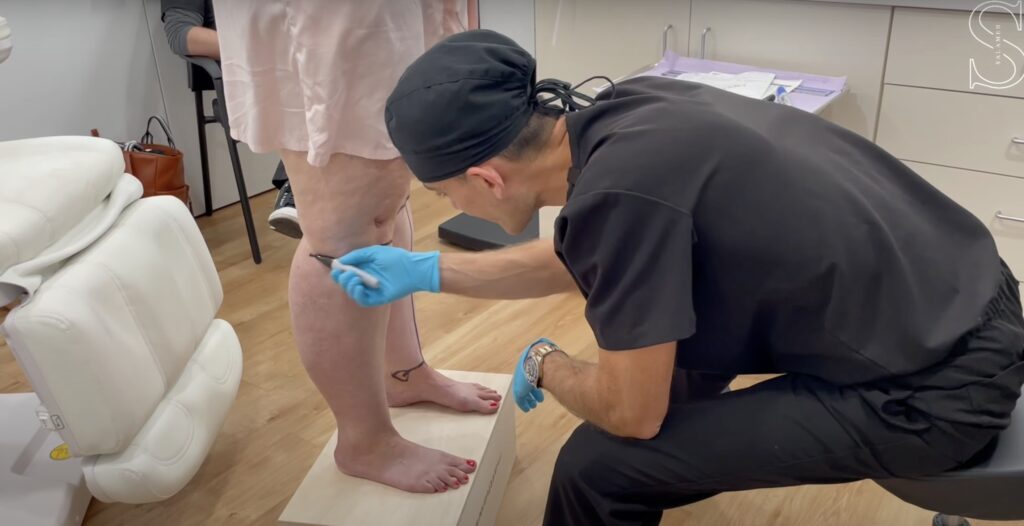Lipedema is a chronic, progressive condition that affects a significant number of women worldwide. Not only is it often misdiagnosed, but its symptoms can also be easily confused with those of other conditions, such as obesity or lymphedema. Understanding lipedema symptoms is crucial for early diagnosis and treatment.
In this blog post, we’ll delve deep into the various symptoms of lipedema, how to recognize them and introduce what makes LippyLipo by Dr. Bernard Salameh, MD, FACS, the best treatment option available today.
What is Lipedema?
Lipedema is a disorder characterized by the abnormal accumulation of fat, typically in the lower part of the body, including the thighs, buttocks, legs, and sometimes arms. This condition predominantly affects women, although men can be affected too, albeit rarely.
Lipedema is misunderstood and often confused with general obesity or lymphedema. Without proper diagnosis and treatment, it can lead to severe complications, both physically and emotionally.
A Comprehensive Guide to Lipedema: Types, Causes, Symptoms, Stages, Treatments, & Prevention
Common Lipedema Symptoms

Recognizing lipedema symptoms is key to getting the proper treatment. Here, we discuss the most telling signs of the disease.
1. Disproportionate Fat Accumulation
This is often the first symptom noticed by individuals suffering from lipedema. The fat is symmetrically distributed across both sides of the body, usually sparing the feet and hands. Even if a person loses weight through diet or exercise, the fat in these areas remains unchanged.
2. Pain and Tenderness
Unlike typical fat, lipedema tissue is unusually tender and painful to the touch. This pain can vary from mild discomfort to severe, debilitating pain that affects daily activities.
3. Easy Bruising
People with lipedema often experience easy bruising, even from minimal trauma. This is due to the fragility of the small blood vessels within the adipose tissue.
4. Skin Texture Changes
The affected areas may develop a nodular or lumpy texture as lipedema progresses. The skin may also feel cooler to the touch than non-affected areas.
5. Edema (Swelling)
Individuals with lipedema often notice swelling in the affected limbs as the day progresses. Unlike lymphedema, this swelling doesn’t significantly reduce with elevation or rest.
6. Mobility Issues
In advanced stages of lipedema, excessive weight and pain can lead to difficulties in mobility, making it hard for patients to walk or perform daily tasks.
7. Emotional and Psychological Impact
Living with lipedema can take an emotional toll, leading to feelings of frustration, depression, and a negative body image. This psychological burden is often compounded by the lack of understanding from medical professionals and society in general.
Diagnosing Lipedema
Since lipedema symptoms can mimic other conditions, a proper diagnosis is crucial. A thorough medical history and physical examination by a knowledgeable healthcare provider is essential. Diagnostic imaging and possibly a biopsy may aid in confirming the diagnosis.
Take Control: Management and Treatment of Lipedema
Once you’ve recognized the lipedema symptoms, the next crucial step is to seek proper treatment. While lipedema can’t be completely cured, several management strategies can help alleviate symptoms and improve the quality of life.
Lipedema Symptoms Conservative Treatment Options

- Manual Lymphatic Drainage (MLD): A specialized form of massage that helps drain lymphatic fluid and reduce swelling.
- Compression Therapy: Wearing compression garments can help control swelling and support the affected limbs.
- Exercise: Low-impact exercises such as swimming, walking, and cycling can help maintain mobility and manage weight.
- Diet: While diet alone can’t cure lipedema, a balanced, anti-inflammatory diet can help manage symptoms.
- Medication: Pain relievers and anti-inflammatory medications can help control pain and swelling.
However, these conservative measures often fall short in addressing the root cause of lipedema. For long-lasting results, surgical interventions such as liposuction are often recommended.
Introducing LippyLipo by Dr. Bernard Salameh, MD, FACS



When considering surgical treatment, choosing a method and specialist with extensive expertise and success in treating lipedema is essential. LippyLipo by Dr. Bernard Salameh, MD, FACS, stands out as today’s best lipedema treatment.
Why Choose LippyLipo?

- Expertise and Experience: Dr. Bernard Salameh is a highly regarded board-certified plastic surgeon with years of experience in treating lipedema. His expertise ensures that each patient receives a personalized and effective treatment plan.
- Innovative Techniques: LippyLipo utilizes advanced liposuction techniques specifically designed to remove the abnormal adipose tissue associated with lipedema. This minimally invasive procedure helps reduce pain, improve mobility, and enhance overall body contour.
- Comprehensive Assessment: Dr. Salameh thoroughly evaluates each patient to devise a tailored treatment plan. This includes a detailed review of medical history, assessment of lipedema symptoms, and diagnostic imaging if needed.
- Patient-Centered Care: At Salameh Plastic Surgery, patient satisfaction and well-being are paramount. From the initial consultation to post-operative care, Dr. Salameh and his team provide compassionate care, ensuring patients feel supported throughout their treatment journey.
- Positive Outcomes: Patients who undergo LippyLipo have reported significant improvements in pain, swelling, and overall quality of life. The procedure addresses physical symptoms and helps boost self-esteem and emotional well-being.
Takeaway
Recognizing lipedema symptoms early and seeking the right treatment can make a world of difference in managing this condition effectively. If you suspect you have lipedema, it’s essential to consult a healthcare provider experienced in diagnosing and treating this condition.
While conservative treatments can provide some relief, surgical options like LippyLipo by Dr. Bernard Salameh, MD, FACS, offer a more definitive solution to alleviate the pain and dysfunction caused by lipedema. By choosing the right treatment, you can take control of your health and improve your quality of life.
If you believe you might be suffering from lipedema, don’t hesitate to seek professional help. Early intervention can prevent progression and help you manage the condition more effectively.
For those considering surgical treatment, book a consultation with Dr. Bernard Salameh and explore the transformative benefits of LippyLipo. Take the first step towards a life free from the burdens of lipedema symptoms.

